Exploring Psychological Interventions for Coping with Sports Injury
VerifiedAdded on 2023/06/15
|12
|3023
|371
Case Study
AI Summary
This case study examines the psychological factors influencing sports injuries, focusing on the experiences of Pam, an elite football player, and Harry, a sprinter. It discusses the similarities in their experiences, the psychological factors that may have contributed to Pam's injury, and her emotional reactions using the Grief Response Model. The study also suggests psychological intervention strategies such as goal setting, positive self-talk, and social support to aid Pam in coping with her injury. The reflection section highlights the author's insights gained from studying the unit, including the impact of stress on athletes and the effectiveness of psychological interventions over acute care. It also discusses the key findings of a journal article on the relationship between physical activity and mental health, and how these findings can be applied in a sport and fitness environment. The assignment is contributed by a student and is available on Desklib.
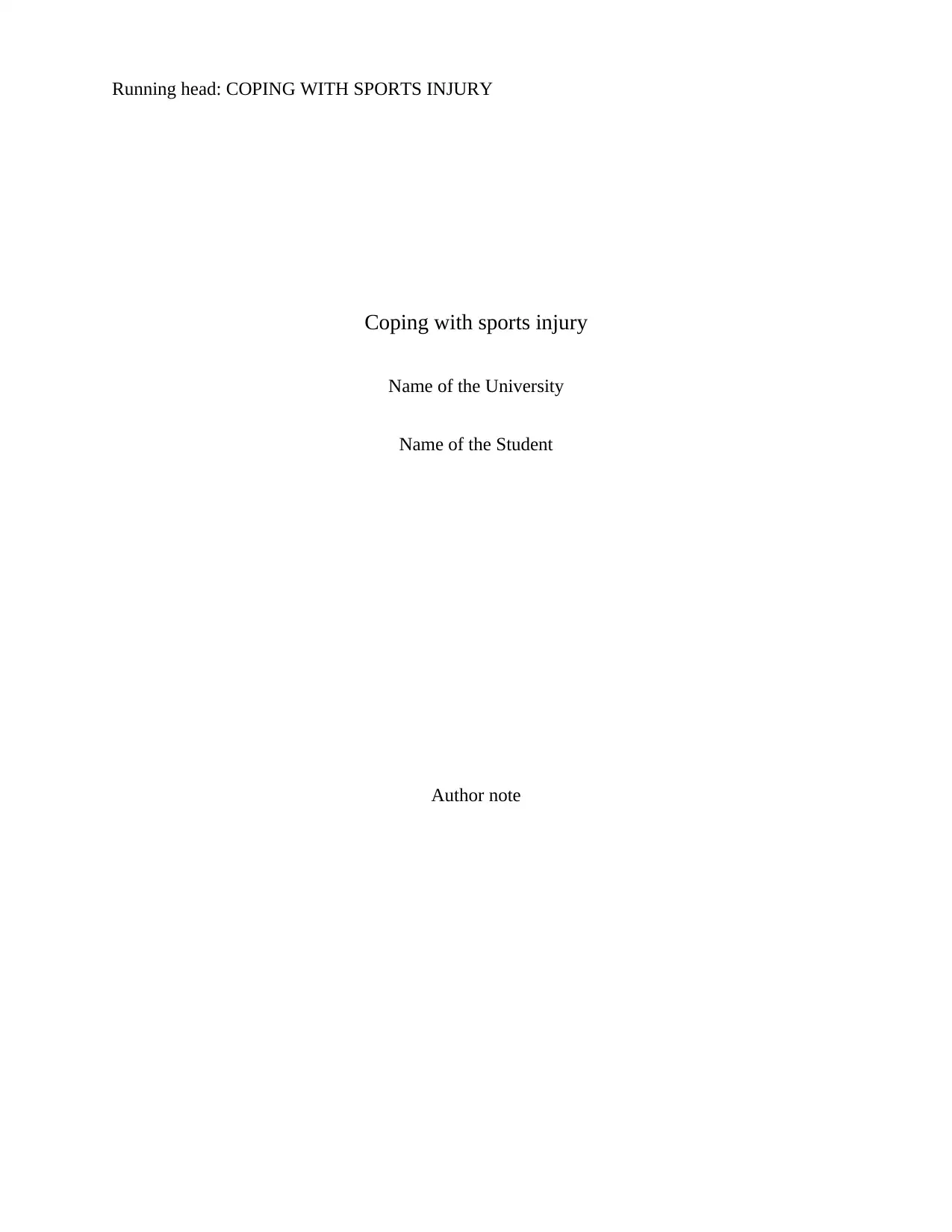
Running head: COPING WITH SPORTS INJURY
Coping with sports injury
Name of the University
Name of the Student
Author note
Coping with sports injury
Name of the University
Name of the Student
Author note
Paraphrase This Document
Need a fresh take? Get an instant paraphrase of this document with our AI Paraphraser
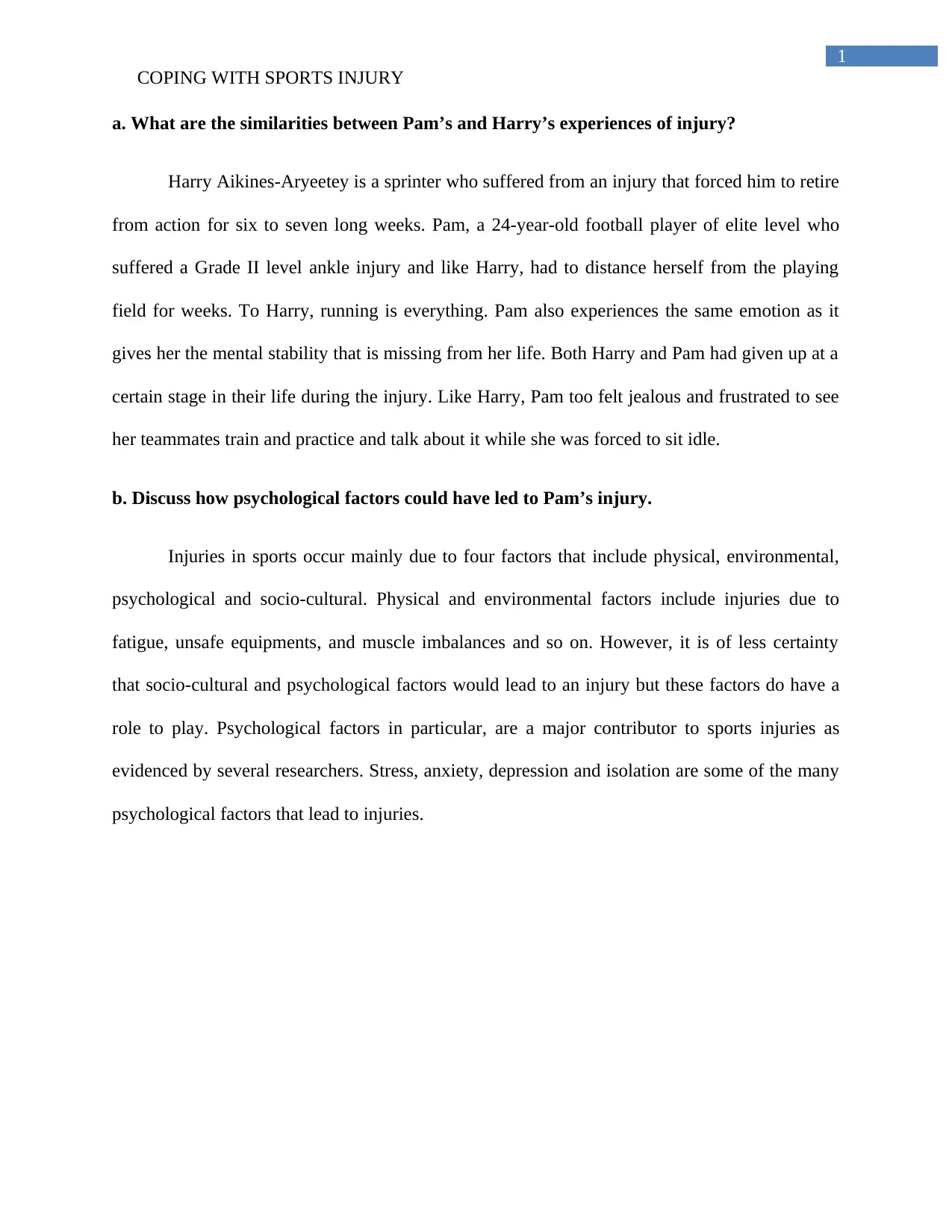
1
COPING WITH SPORTS INJURY
a. What are the similarities between Pam’s and Harry’s experiences of injury?
Harry Aikines-Aryeetey is a sprinter who suffered from an injury that forced him to retire
from action for six to seven long weeks. Pam, a 24-year-old football player of elite level who
suffered a Grade II level ankle injury and like Harry, had to distance herself from the playing
field for weeks. To Harry, running is everything. Pam also experiences the same emotion as it
gives her the mental stability that is missing from her life. Both Harry and Pam had given up at a
certain stage in their life during the injury. Like Harry, Pam too felt jealous and frustrated to see
her teammates train and practice and talk about it while she was forced to sit idle.
b. Discuss how psychological factors could have led to Pam’s injury.
Injuries in sports occur mainly due to four factors that include physical, environmental,
psychological and socio-cultural. Physical and environmental factors include injuries due to
fatigue, unsafe equipments, and muscle imbalances and so on. However, it is of less certainty
that socio-cultural and psychological factors would lead to an injury but these factors do have a
role to play. Psychological factors in particular, are a major contributor to sports injuries as
evidenced by several researchers. Stress, anxiety, depression and isolation are some of the many
psychological factors that lead to injuries.
COPING WITH SPORTS INJURY
a. What are the similarities between Pam’s and Harry’s experiences of injury?
Harry Aikines-Aryeetey is a sprinter who suffered from an injury that forced him to retire
from action for six to seven long weeks. Pam, a 24-year-old football player of elite level who
suffered a Grade II level ankle injury and like Harry, had to distance herself from the playing
field for weeks. To Harry, running is everything. Pam also experiences the same emotion as it
gives her the mental stability that is missing from her life. Both Harry and Pam had given up at a
certain stage in their life during the injury. Like Harry, Pam too felt jealous and frustrated to see
her teammates train and practice and talk about it while she was forced to sit idle.
b. Discuss how psychological factors could have led to Pam’s injury.
Injuries in sports occur mainly due to four factors that include physical, environmental,
psychological and socio-cultural. Physical and environmental factors include injuries due to
fatigue, unsafe equipments, and muscle imbalances and so on. However, it is of less certainty
that socio-cultural and psychological factors would lead to an injury but these factors do have a
role to play. Psychological factors in particular, are a major contributor to sports injuries as
evidenced by several researchers. Stress, anxiety, depression and isolation are some of the many
psychological factors that lead to injuries.
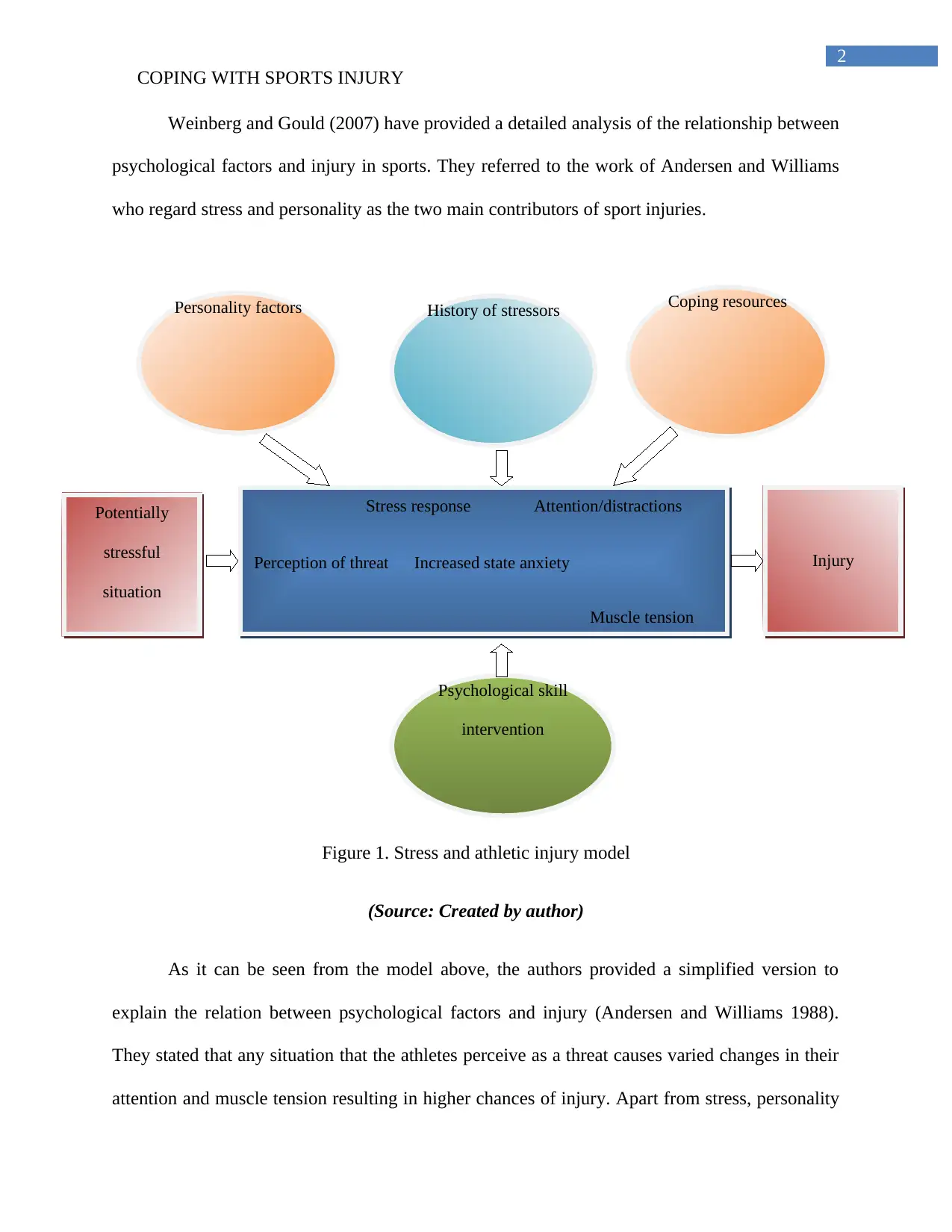
2
COPING WITH SPORTS INJURY
Weinberg and Gould (2007) have provided a detailed analysis of the relationship between
psychological factors and injury in sports. They referred to the work of Andersen and Williams
who regard stress and personality as the two main contributors of sport injuries.
Figure 1. Stress and athletic injury model
(Source: Created by author)
As it can be seen from the model above, the authors provided a simplified version to
explain the relation between psychological factors and injury (Andersen and Williams 1988).
They stated that any situation that the athletes perceive as a threat causes varied changes in their
attention and muscle tension resulting in higher chances of injury. Apart from stress, personality
Personality factors Coping resources
History of stressors
Psychological skill
intervention
Stress response Attention/distractions
Perception of threat Increased state anxiety
Muscle tension
Potentially
stressful
situation
Injury
COPING WITH SPORTS INJURY
Weinberg and Gould (2007) have provided a detailed analysis of the relationship between
psychological factors and injury in sports. They referred to the work of Andersen and Williams
who regard stress and personality as the two main contributors of sport injuries.
Figure 1. Stress and athletic injury model
(Source: Created by author)
As it can be seen from the model above, the authors provided a simplified version to
explain the relation between psychological factors and injury (Andersen and Williams 1988).
They stated that any situation that the athletes perceive as a threat causes varied changes in their
attention and muscle tension resulting in higher chances of injury. Apart from stress, personality
Personality factors Coping resources
History of stressors
Psychological skill
intervention
Stress response Attention/distractions
Perception of threat Increased state anxiety
Muscle tension
Potentially
stressful
situation
Injury
⊘ This is a preview!⊘
Do you want full access?
Subscribe today to unlock all pages.

Trusted by 1+ million students worldwide
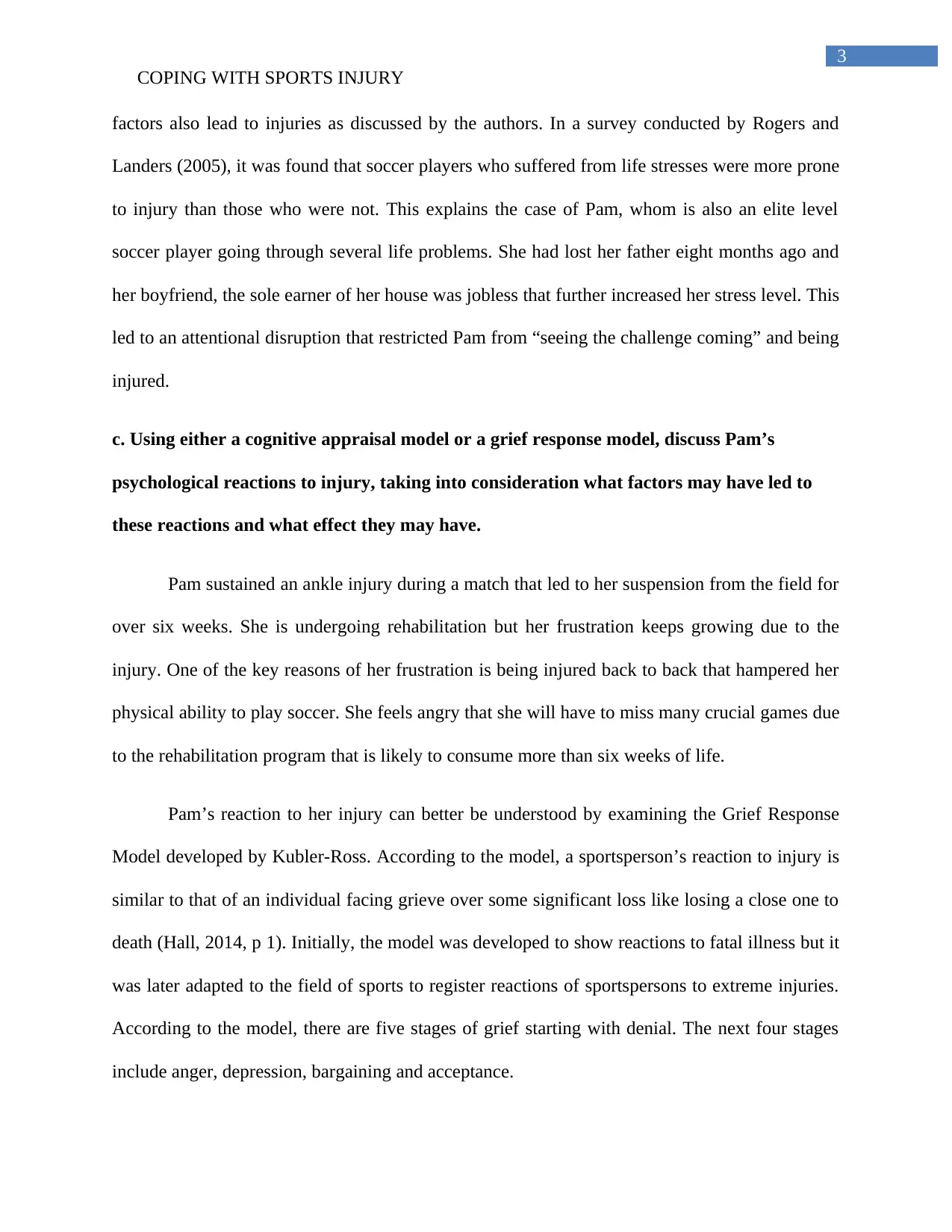
3
COPING WITH SPORTS INJURY
factors also lead to injuries as discussed by the authors. In a survey conducted by Rogers and
Landers (2005), it was found that soccer players who suffered from life stresses were more prone
to injury than those who were not. This explains the case of Pam, whom is also an elite level
soccer player going through several life problems. She had lost her father eight months ago and
her boyfriend, the sole earner of her house was jobless that further increased her stress level. This
led to an attentional disruption that restricted Pam from “seeing the challenge coming” and being
injured.
c. Using either a cognitive appraisal model or a grief response model, discuss Pam’s
psychological reactions to injury, taking into consideration what factors may have led to
these reactions and what effect they may have.
Pam sustained an ankle injury during a match that led to her suspension from the field for
over six weeks. She is undergoing rehabilitation but her frustration keeps growing due to the
injury. One of the key reasons of her frustration is being injured back to back that hampered her
physical ability to play soccer. She feels angry that she will have to miss many crucial games due
to the rehabilitation program that is likely to consume more than six weeks of life.
Pam’s reaction to her injury can better be understood by examining the Grief Response
Model developed by Kubler-Ross. According to the model, a sportsperson’s reaction to injury is
similar to that of an individual facing grieve over some significant loss like losing a close one to
death (Hall, 2014, p 1). Initially, the model was developed to show reactions to fatal illness but it
was later adapted to the field of sports to register reactions of sportspersons to extreme injuries.
According to the model, there are five stages of grief starting with denial. The next four stages
include anger, depression, bargaining and acceptance.
COPING WITH SPORTS INJURY
factors also lead to injuries as discussed by the authors. In a survey conducted by Rogers and
Landers (2005), it was found that soccer players who suffered from life stresses were more prone
to injury than those who were not. This explains the case of Pam, whom is also an elite level
soccer player going through several life problems. She had lost her father eight months ago and
her boyfriend, the sole earner of her house was jobless that further increased her stress level. This
led to an attentional disruption that restricted Pam from “seeing the challenge coming” and being
injured.
c. Using either a cognitive appraisal model or a grief response model, discuss Pam’s
psychological reactions to injury, taking into consideration what factors may have led to
these reactions and what effect they may have.
Pam sustained an ankle injury during a match that led to her suspension from the field for
over six weeks. She is undergoing rehabilitation but her frustration keeps growing due to the
injury. One of the key reasons of her frustration is being injured back to back that hampered her
physical ability to play soccer. She feels angry that she will have to miss many crucial games due
to the rehabilitation program that is likely to consume more than six weeks of life.
Pam’s reaction to her injury can better be understood by examining the Grief Response
Model developed by Kubler-Ross. According to the model, a sportsperson’s reaction to injury is
similar to that of an individual facing grieve over some significant loss like losing a close one to
death (Hall, 2014, p 1). Initially, the model was developed to show reactions to fatal illness but it
was later adapted to the field of sports to register reactions of sportspersons to extreme injuries.
According to the model, there are five stages of grief starting with denial. The next four stages
include anger, depression, bargaining and acceptance.
Paraphrase This Document
Need a fresh take? Get an instant paraphrase of this document with our AI Paraphraser
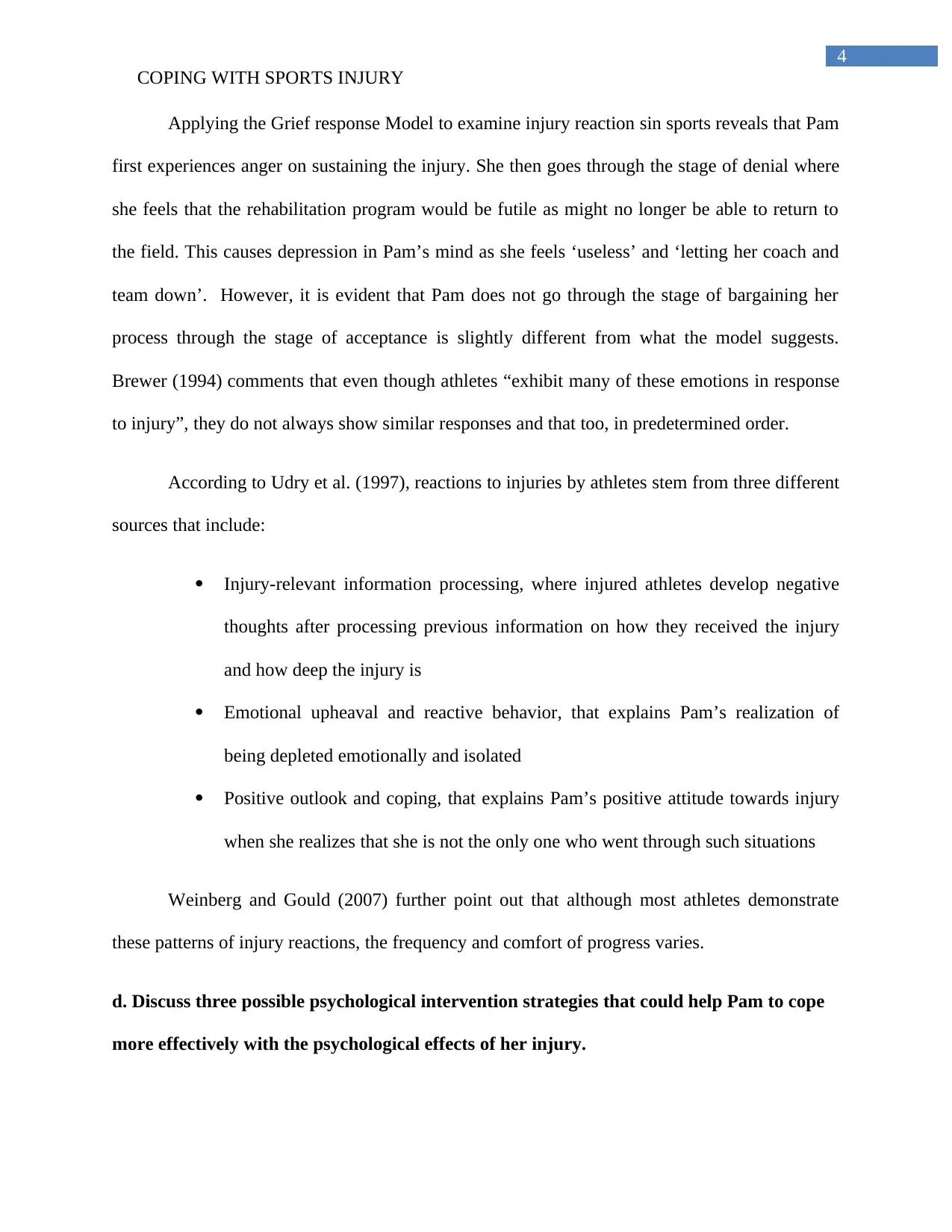
4
COPING WITH SPORTS INJURY
Applying the Grief response Model to examine injury reaction sin sports reveals that Pam
first experiences anger on sustaining the injury. She then goes through the stage of denial where
she feels that the rehabilitation program would be futile as might no longer be able to return to
the field. This causes depression in Pam’s mind as she feels ‘useless’ and ‘letting her coach and
team down’. However, it is evident that Pam does not go through the stage of bargaining her
process through the stage of acceptance is slightly different from what the model suggests.
Brewer (1994) comments that even though athletes “exhibit many of these emotions in response
to injury”, they do not always show similar responses and that too, in predetermined order.
According to Udry et al. (1997), reactions to injuries by athletes stem from three different
sources that include:
Injury-relevant information processing, where injured athletes develop negative
thoughts after processing previous information on how they received the injury
and how deep the injury is
Emotional upheaval and reactive behavior, that explains Pam’s realization of
being depleted emotionally and isolated
Positive outlook and coping, that explains Pam’s positive attitude towards injury
when she realizes that she is not the only one who went through such situations
Weinberg and Gould (2007) further point out that although most athletes demonstrate
these patterns of injury reactions, the frequency and comfort of progress varies.
d. Discuss three possible psychological intervention strategies that could help Pam to cope
more effectively with the psychological effects of her injury.
COPING WITH SPORTS INJURY
Applying the Grief response Model to examine injury reaction sin sports reveals that Pam
first experiences anger on sustaining the injury. She then goes through the stage of denial where
she feels that the rehabilitation program would be futile as might no longer be able to return to
the field. This causes depression in Pam’s mind as she feels ‘useless’ and ‘letting her coach and
team down’. However, it is evident that Pam does not go through the stage of bargaining her
process through the stage of acceptance is slightly different from what the model suggests.
Brewer (1994) comments that even though athletes “exhibit many of these emotions in response
to injury”, they do not always show similar responses and that too, in predetermined order.
According to Udry et al. (1997), reactions to injuries by athletes stem from three different
sources that include:
Injury-relevant information processing, where injured athletes develop negative
thoughts after processing previous information on how they received the injury
and how deep the injury is
Emotional upheaval and reactive behavior, that explains Pam’s realization of
being depleted emotionally and isolated
Positive outlook and coping, that explains Pam’s positive attitude towards injury
when she realizes that she is not the only one who went through such situations
Weinberg and Gould (2007) further point out that although most athletes demonstrate
these patterns of injury reactions, the frequency and comfort of progress varies.
d. Discuss three possible psychological intervention strategies that could help Pam to cope
more effectively with the psychological effects of her injury.
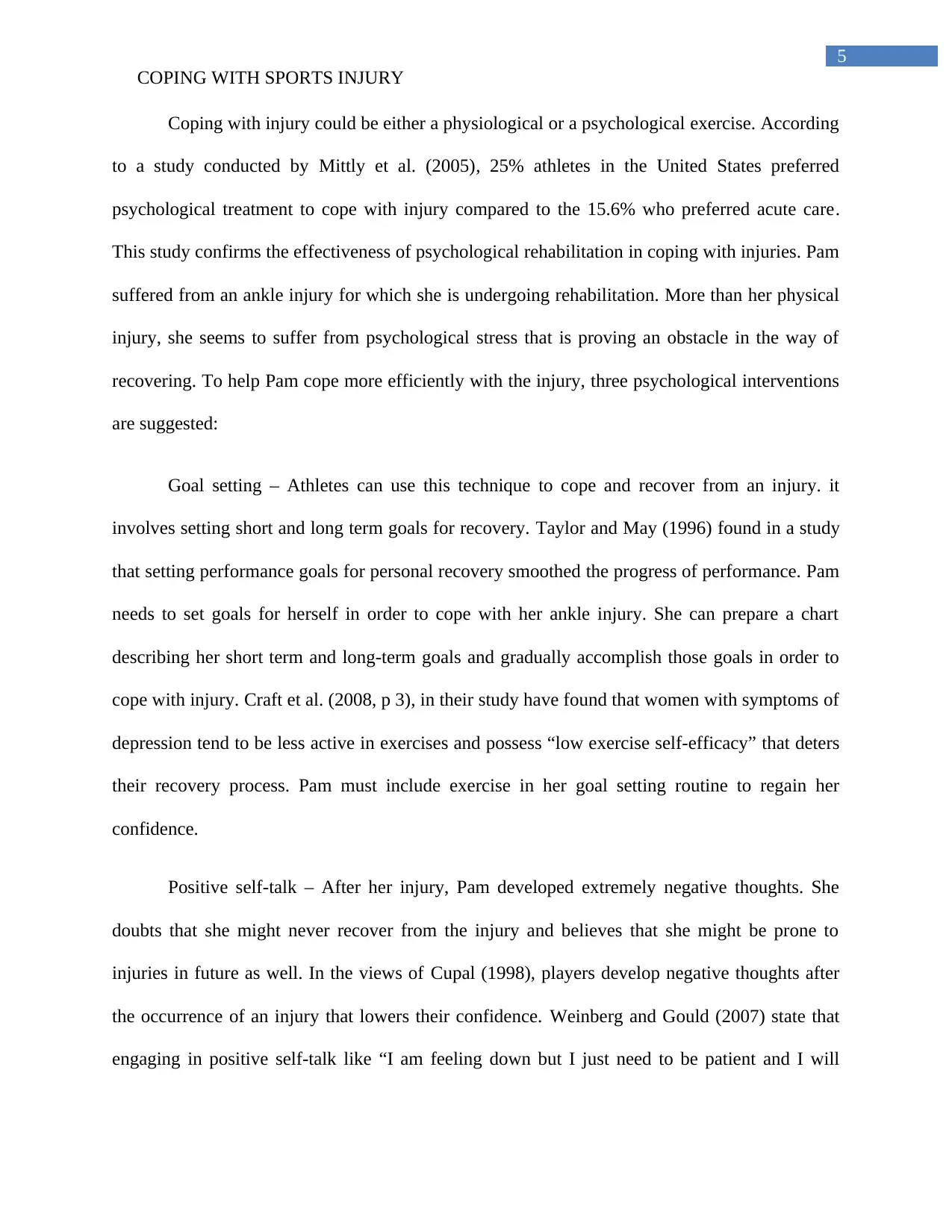
5
COPING WITH SPORTS INJURY
Coping with injury could be either a physiological or a psychological exercise. According
to a study conducted by Mittly et al. (2005), 25% athletes in the United States preferred
psychological treatment to cope with injury compared to the 15.6% who preferred acute care.
This study confirms the effectiveness of psychological rehabilitation in coping with injuries. Pam
suffered from an ankle injury for which she is undergoing rehabilitation. More than her physical
injury, she seems to suffer from psychological stress that is proving an obstacle in the way of
recovering. To help Pam cope more efficiently with the injury, three psychological interventions
are suggested:
Goal setting – Athletes can use this technique to cope and recover from an injury. it
involves setting short and long term goals for recovery. Taylor and May (1996) found in a study
that setting performance goals for personal recovery smoothed the progress of performance. Pam
needs to set goals for herself in order to cope with her ankle injury. She can prepare a chart
describing her short term and long-term goals and gradually accomplish those goals in order to
cope with injury. Craft et al. (2008, p 3), in their study have found that women with symptoms of
depression tend to be less active in exercises and possess “low exercise self-efficacy” that deters
their recovery process. Pam must include exercise in her goal setting routine to regain her
confidence.
Positive self-talk – After her injury, Pam developed extremely negative thoughts. She
doubts that she might never recover from the injury and believes that she might be prone to
injuries in future as well. In the views of Cupal (1998), players develop negative thoughts after
the occurrence of an injury that lowers their confidence. Weinberg and Gould (2007) state that
engaging in positive self-talk like “I am feeling down but I just need to be patient and I will
COPING WITH SPORTS INJURY
Coping with injury could be either a physiological or a psychological exercise. According
to a study conducted by Mittly et al. (2005), 25% athletes in the United States preferred
psychological treatment to cope with injury compared to the 15.6% who preferred acute care.
This study confirms the effectiveness of psychological rehabilitation in coping with injuries. Pam
suffered from an ankle injury for which she is undergoing rehabilitation. More than her physical
injury, she seems to suffer from psychological stress that is proving an obstacle in the way of
recovering. To help Pam cope more efficiently with the injury, three psychological interventions
are suggested:
Goal setting – Athletes can use this technique to cope and recover from an injury. it
involves setting short and long term goals for recovery. Taylor and May (1996) found in a study
that setting performance goals for personal recovery smoothed the progress of performance. Pam
needs to set goals for herself in order to cope with her ankle injury. She can prepare a chart
describing her short term and long-term goals and gradually accomplish those goals in order to
cope with injury. Craft et al. (2008, p 3), in their study have found that women with symptoms of
depression tend to be less active in exercises and possess “low exercise self-efficacy” that deters
their recovery process. Pam must include exercise in her goal setting routine to regain her
confidence.
Positive self-talk – After her injury, Pam developed extremely negative thoughts. She
doubts that she might never recover from the injury and believes that she might be prone to
injuries in future as well. In the views of Cupal (1998), players develop negative thoughts after
the occurrence of an injury that lowers their confidence. Weinberg and Gould (2007) state that
engaging in positive self-talk like “I am feeling down but I just need to be patient and I will
⊘ This is a preview!⊘
Do you want full access?
Subscribe today to unlock all pages.

Trusted by 1+ million students worldwide
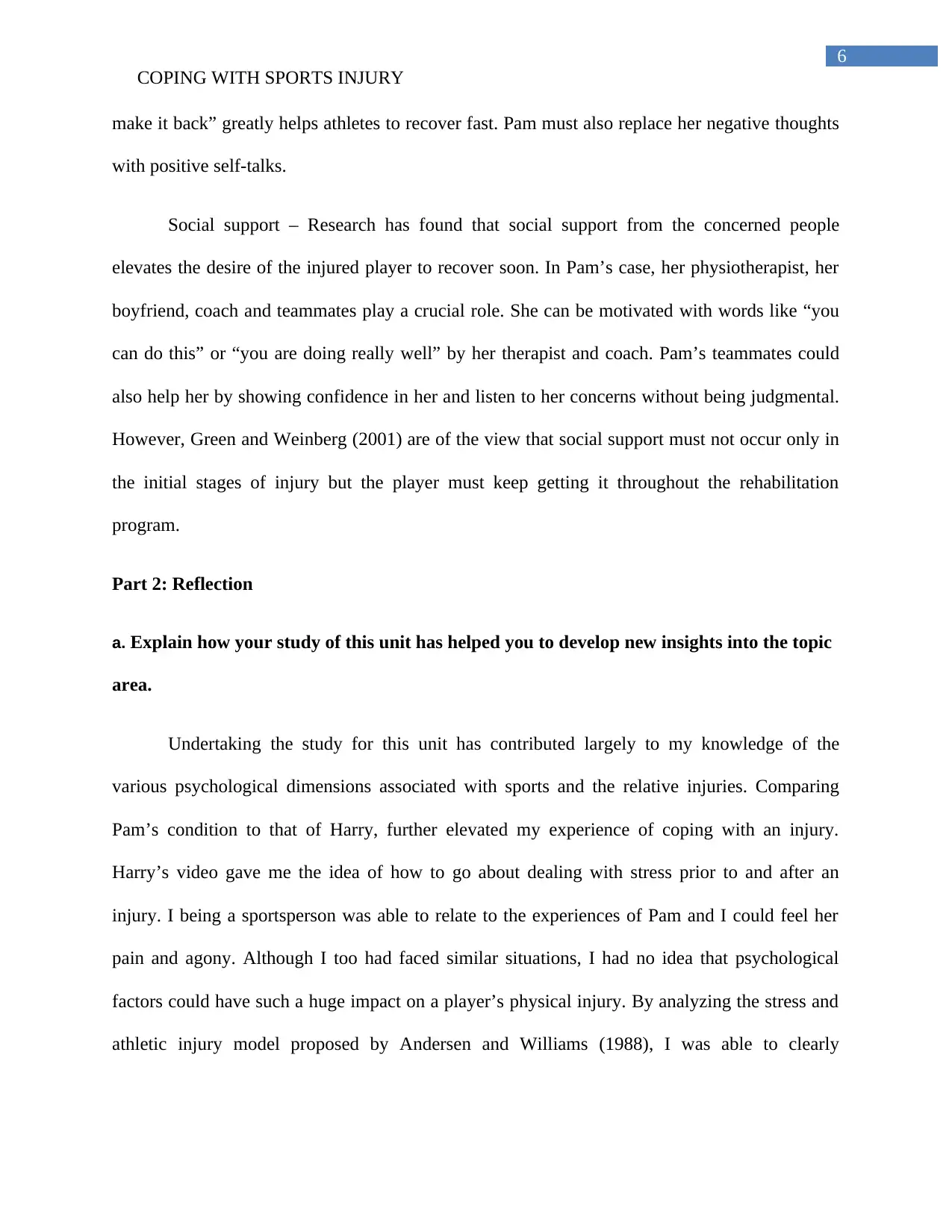
6
COPING WITH SPORTS INJURY
make it back” greatly helps athletes to recover fast. Pam must also replace her negative thoughts
with positive self-talks.
Social support – Research has found that social support from the concerned people
elevates the desire of the injured player to recover soon. In Pam’s case, her physiotherapist, her
boyfriend, coach and teammates play a crucial role. She can be motivated with words like “you
can do this” or “you are doing really well” by her therapist and coach. Pam’s teammates could
also help her by showing confidence in her and listen to her concerns without being judgmental.
However, Green and Weinberg (2001) are of the view that social support must not occur only in
the initial stages of injury but the player must keep getting it throughout the rehabilitation
program.
Part 2: Reflection
a. Explain how your study of this unit has helped you to develop new insights into the topic
area.
Undertaking the study for this unit has contributed largely to my knowledge of the
various psychological dimensions associated with sports and the relative injuries. Comparing
Pam’s condition to that of Harry, further elevated my experience of coping with an injury.
Harry’s video gave me the idea of how to go about dealing with stress prior to and after an
injury. I being a sportsperson was able to relate to the experiences of Pam and I could feel her
pain and agony. Although I too had faced similar situations, I had no idea that psychological
factors could have such a huge impact on a player’s physical injury. By analyzing the stress and
athletic injury model proposed by Andersen and Williams (1988), I was able to clearly
COPING WITH SPORTS INJURY
make it back” greatly helps athletes to recover fast. Pam must also replace her negative thoughts
with positive self-talks.
Social support – Research has found that social support from the concerned people
elevates the desire of the injured player to recover soon. In Pam’s case, her physiotherapist, her
boyfriend, coach and teammates play a crucial role. She can be motivated with words like “you
can do this” or “you are doing really well” by her therapist and coach. Pam’s teammates could
also help her by showing confidence in her and listen to her concerns without being judgmental.
However, Green and Weinberg (2001) are of the view that social support must not occur only in
the initial stages of injury but the player must keep getting it throughout the rehabilitation
program.
Part 2: Reflection
a. Explain how your study of this unit has helped you to develop new insights into the topic
area.
Undertaking the study for this unit has contributed largely to my knowledge of the
various psychological dimensions associated with sports and the relative injuries. Comparing
Pam’s condition to that of Harry, further elevated my experience of coping with an injury.
Harry’s video gave me the idea of how to go about dealing with stress prior to and after an
injury. I being a sportsperson was able to relate to the experiences of Pam and I could feel her
pain and agony. Although I too had faced similar situations, I had no idea that psychological
factors could have such a huge impact on a player’s physical injury. By analyzing the stress and
athletic injury model proposed by Andersen and Williams (1988), I was able to clearly
Paraphrase This Document
Need a fresh take? Get an instant paraphrase of this document with our AI Paraphraser
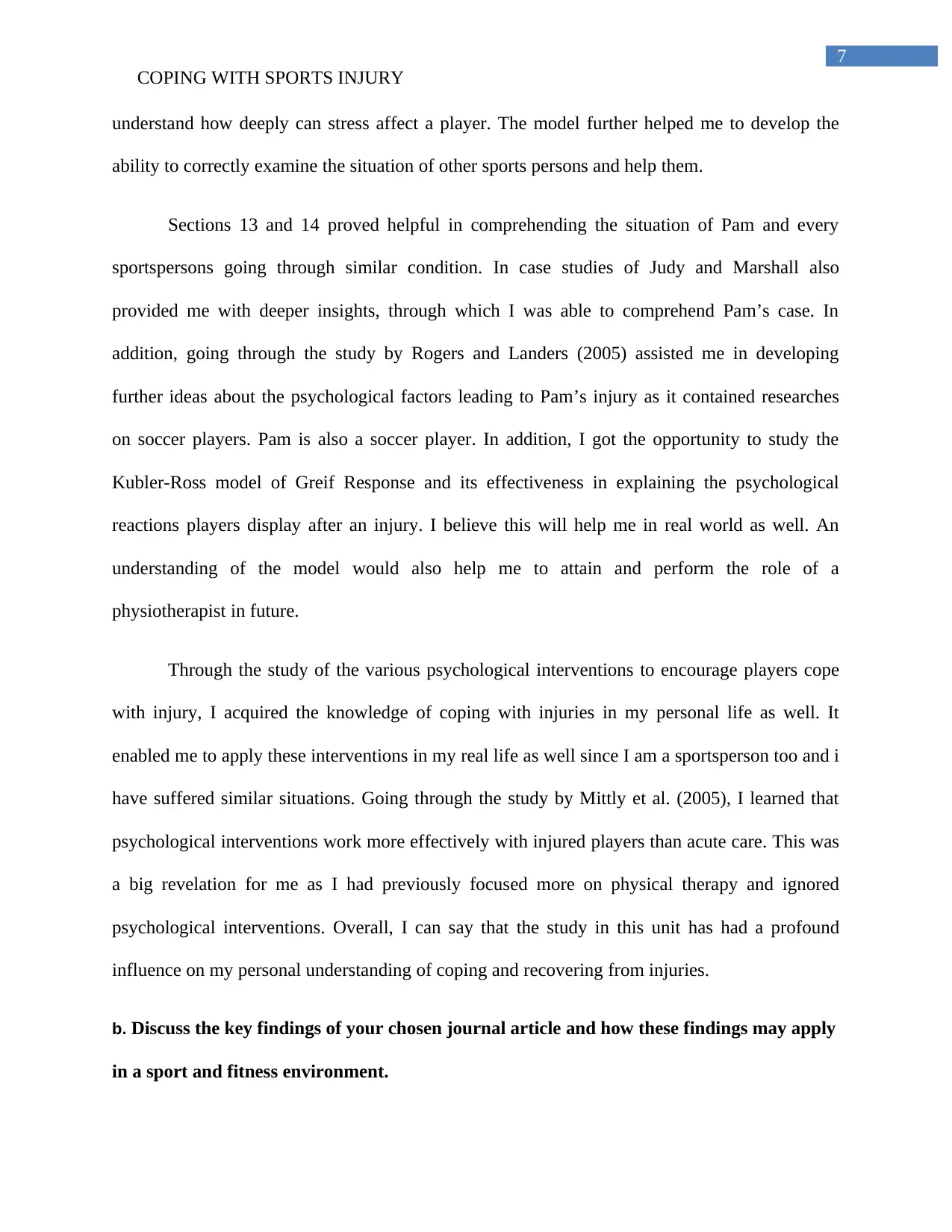
7
COPING WITH SPORTS INJURY
understand how deeply can stress affect a player. The model further helped me to develop the
ability to correctly examine the situation of other sports persons and help them.
Sections 13 and 14 proved helpful in comprehending the situation of Pam and every
sportspersons going through similar condition. In case studies of Judy and Marshall also
provided me with deeper insights, through which I was able to comprehend Pam’s case. In
addition, going through the study by Rogers and Landers (2005) assisted me in developing
further ideas about the psychological factors leading to Pam’s injury as it contained researches
on soccer players. Pam is also a soccer player. In addition, I got the opportunity to study the
Kubler-Ross model of Greif Response and its effectiveness in explaining the psychological
reactions players display after an injury. I believe this will help me in real world as well. An
understanding of the model would also help me to attain and perform the role of a
physiotherapist in future.
Through the study of the various psychological interventions to encourage players cope
with injury, I acquired the knowledge of coping with injuries in my personal life as well. It
enabled me to apply these interventions in my real life as well since I am a sportsperson too and i
have suffered similar situations. Going through the study by Mittly et al. (2005), I learned that
psychological interventions work more effectively with injured players than acute care. This was
a big revelation for me as I had previously focused more on physical therapy and ignored
psychological interventions. Overall, I can say that the study in this unit has had a profound
influence on my personal understanding of coping and recovering from injuries.
b. Discuss the key findings of your chosen journal article and how these findings may apply
in a sport and fitness environment.
COPING WITH SPORTS INJURY
understand how deeply can stress affect a player. The model further helped me to develop the
ability to correctly examine the situation of other sports persons and help them.
Sections 13 and 14 proved helpful in comprehending the situation of Pam and every
sportspersons going through similar condition. In case studies of Judy and Marshall also
provided me with deeper insights, through which I was able to comprehend Pam’s case. In
addition, going through the study by Rogers and Landers (2005) assisted me in developing
further ideas about the psychological factors leading to Pam’s injury as it contained researches
on soccer players. Pam is also a soccer player. In addition, I got the opportunity to study the
Kubler-Ross model of Greif Response and its effectiveness in explaining the psychological
reactions players display after an injury. I believe this will help me in real world as well. An
understanding of the model would also help me to attain and perform the role of a
physiotherapist in future.
Through the study of the various psychological interventions to encourage players cope
with injury, I acquired the knowledge of coping with injuries in my personal life as well. It
enabled me to apply these interventions in my real life as well since I am a sportsperson too and i
have suffered similar situations. Going through the study by Mittly et al. (2005), I learned that
psychological interventions work more effectively with injured players than acute care. This was
a big revelation for me as I had previously focused more on physical therapy and ignored
psychological interventions. Overall, I can say that the study in this unit has had a profound
influence on my personal understanding of coping and recovering from injuries.
b. Discuss the key findings of your chosen journal article and how these findings may apply
in a sport and fitness environment.
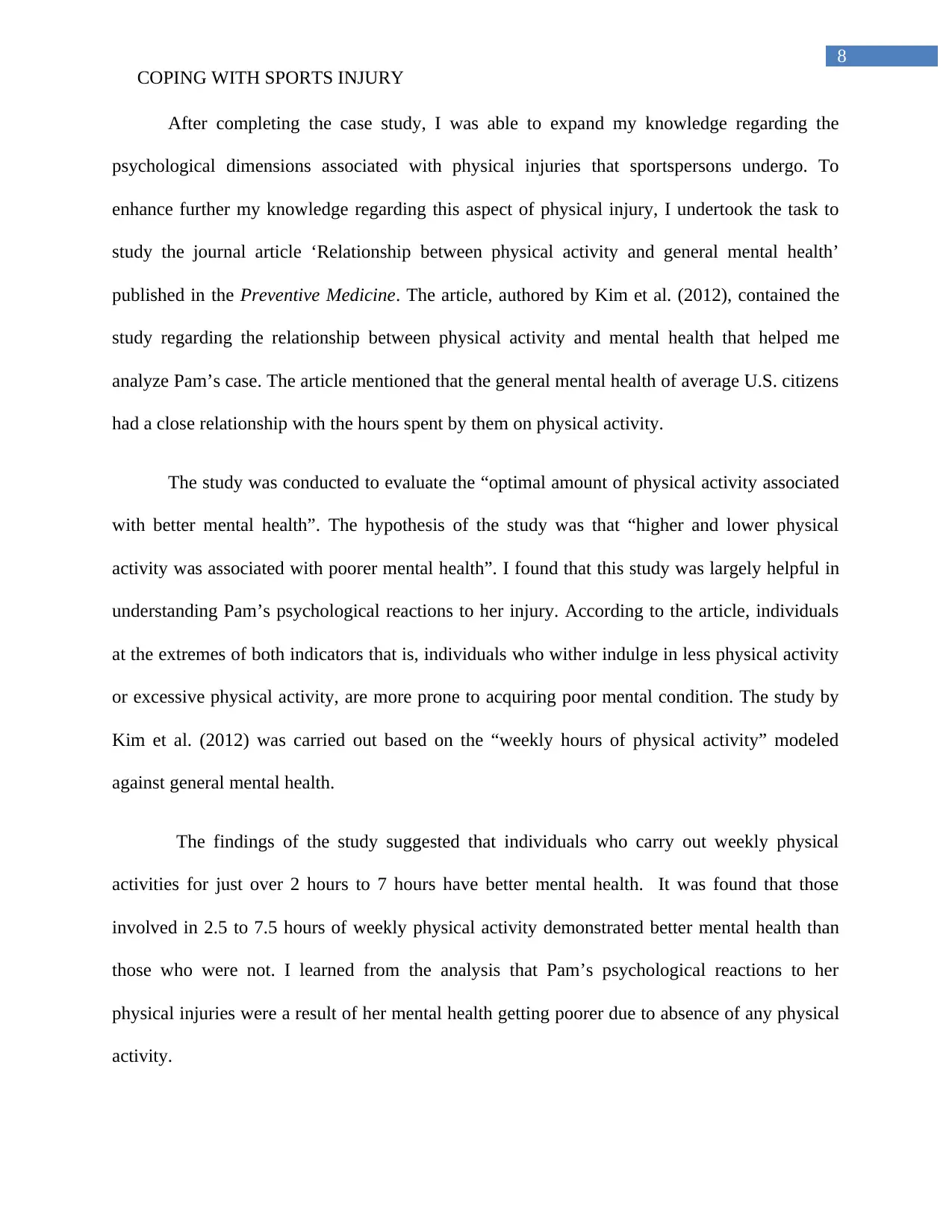
8
COPING WITH SPORTS INJURY
After completing the case study, I was able to expand my knowledge regarding the
psychological dimensions associated with physical injuries that sportspersons undergo. To
enhance further my knowledge regarding this aspect of physical injury, I undertook the task to
study the journal article ‘Relationship between physical activity and general mental health’
published in the Preventive Medicine. The article, authored by Kim et al. (2012), contained the
study regarding the relationship between physical activity and mental health that helped me
analyze Pam’s case. The article mentioned that the general mental health of average U.S. citizens
had a close relationship with the hours spent by them on physical activity.
The study was conducted to evaluate the “optimal amount of physical activity associated
with better mental health”. The hypothesis of the study was that “higher and lower physical
activity was associated with poorer mental health”. I found that this study was largely helpful in
understanding Pam’s psychological reactions to her injury. According to the article, individuals
at the extremes of both indicators that is, individuals who wither indulge in less physical activity
or excessive physical activity, are more prone to acquiring poor mental condition. The study by
Kim et al. (2012) was carried out based on the “weekly hours of physical activity” modeled
against general mental health.
The findings of the study suggested that individuals who carry out weekly physical
activities for just over 2 hours to 7 hours have better mental health. It was found that those
involved in 2.5 to 7.5 hours of weekly physical activity demonstrated better mental health than
those who were not. I learned from the analysis that Pam’s psychological reactions to her
physical injuries were a result of her mental health getting poorer due to absence of any physical
activity.
COPING WITH SPORTS INJURY
After completing the case study, I was able to expand my knowledge regarding the
psychological dimensions associated with physical injuries that sportspersons undergo. To
enhance further my knowledge regarding this aspect of physical injury, I undertook the task to
study the journal article ‘Relationship between physical activity and general mental health’
published in the Preventive Medicine. The article, authored by Kim et al. (2012), contained the
study regarding the relationship between physical activity and mental health that helped me
analyze Pam’s case. The article mentioned that the general mental health of average U.S. citizens
had a close relationship with the hours spent by them on physical activity.
The study was conducted to evaluate the “optimal amount of physical activity associated
with better mental health”. The hypothesis of the study was that “higher and lower physical
activity was associated with poorer mental health”. I found that this study was largely helpful in
understanding Pam’s psychological reactions to her injury. According to the article, individuals
at the extremes of both indicators that is, individuals who wither indulge in less physical activity
or excessive physical activity, are more prone to acquiring poor mental condition. The study by
Kim et al. (2012) was carried out based on the “weekly hours of physical activity” modeled
against general mental health.
The findings of the study suggested that individuals who carry out weekly physical
activities for just over 2 hours to 7 hours have better mental health. It was found that those
involved in 2.5 to 7.5 hours of weekly physical activity demonstrated better mental health than
those who were not. I learned from the analysis that Pam’s psychological reactions to her
physical injuries were a result of her mental health getting poorer due to absence of any physical
activity.
⊘ This is a preview!⊘
Do you want full access?
Subscribe today to unlock all pages.

Trusted by 1+ million students worldwide
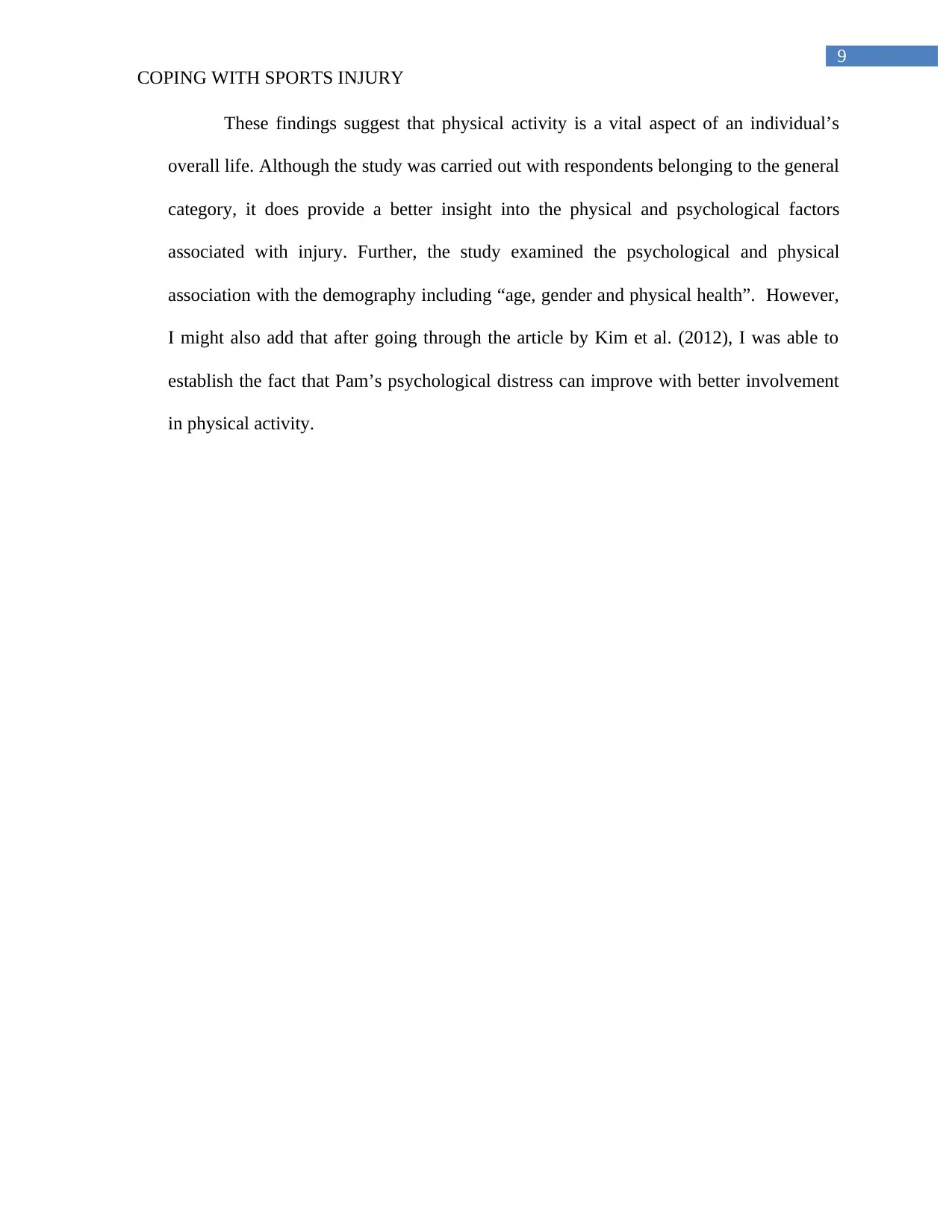
9
COPING WITH SPORTS INJURY
These findings suggest that physical activity is a vital aspect of an individual’s
overall life. Although the study was carried out with respondents belonging to the general
category, it does provide a better insight into the physical and psychological factors
associated with injury. Further, the study examined the psychological and physical
association with the demography including “age, gender and physical health”. However,
I might also add that after going through the article by Kim et al. (2012), I was able to
establish the fact that Pam’s psychological distress can improve with better involvement
in physical activity.
COPING WITH SPORTS INJURY
These findings suggest that physical activity is a vital aspect of an individual’s
overall life. Although the study was carried out with respondents belonging to the general
category, it does provide a better insight into the physical and psychological factors
associated with injury. Further, the study examined the psychological and physical
association with the demography including “age, gender and physical health”. However,
I might also add that after going through the article by Kim et al. (2012), I was able to
establish the fact that Pam’s psychological distress can improve with better involvement
in physical activity.
Paraphrase This Document
Need a fresh take? Get an instant paraphrase of this document with our AI Paraphraser
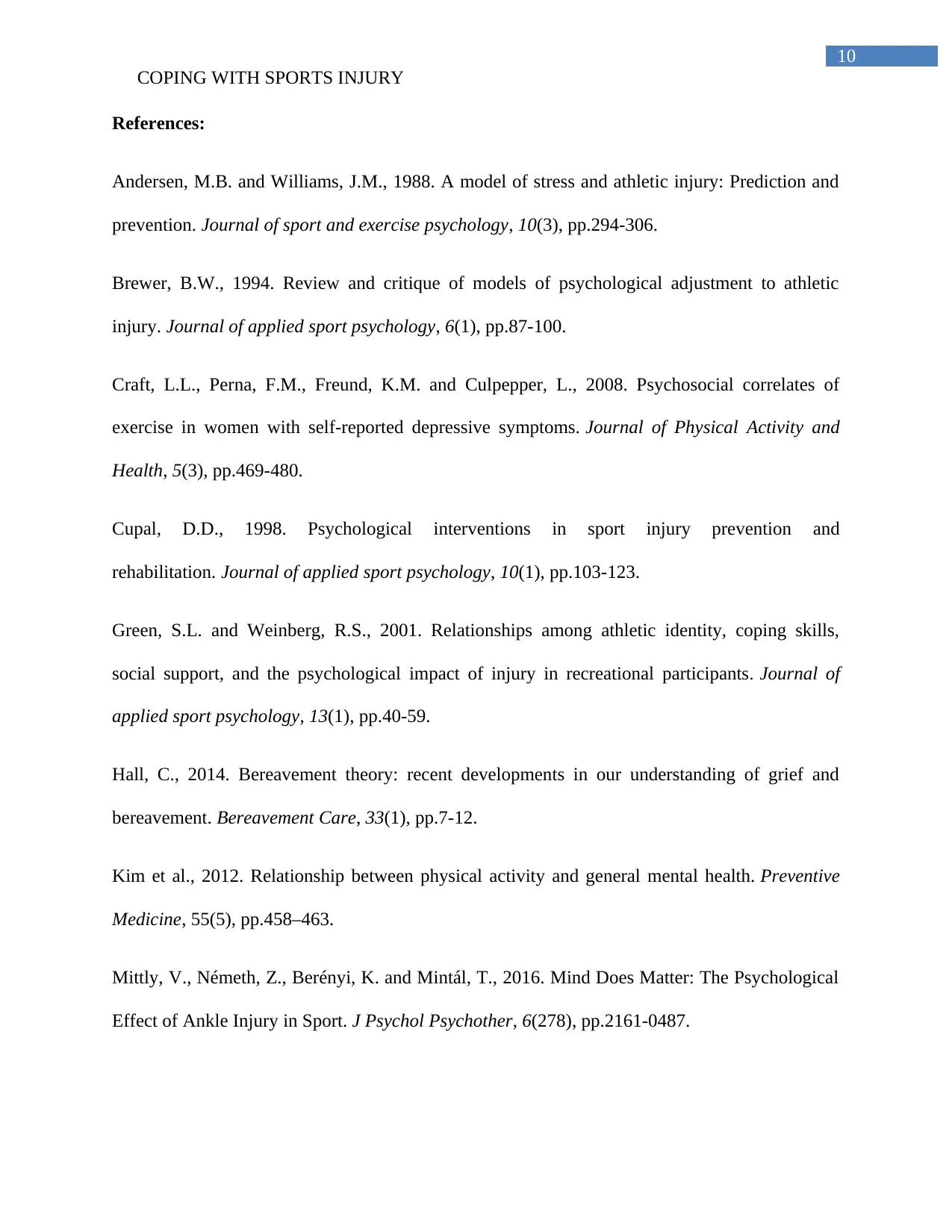
10
COPING WITH SPORTS INJURY
References:
Andersen, M.B. and Williams, J.M., 1988. A model of stress and athletic injury: Prediction and
prevention. Journal of sport and exercise psychology, 10(3), pp.294-306.
Brewer, B.W., 1994. Review and critique of models of psychological adjustment to athletic
injury. Journal of applied sport psychology, 6(1), pp.87-100.
Craft, L.L., Perna, F.M., Freund, K.M. and Culpepper, L., 2008. Psychosocial correlates of
exercise in women with self-reported depressive symptoms. Journal of Physical Activity and
Health, 5(3), pp.469-480.
Cupal, D.D., 1998. Psychological interventions in sport injury prevention and
rehabilitation. Journal of applied sport psychology, 10(1), pp.103-123.
Green, S.L. and Weinberg, R.S., 2001. Relationships among athletic identity, coping skills,
social support, and the psychological impact of injury in recreational participants. Journal of
applied sport psychology, 13(1), pp.40-59.
Hall, C., 2014. Bereavement theory: recent developments in our understanding of grief and
bereavement. Bereavement Care, 33(1), pp.7-12.
Kim et al., 2012. Relationship between physical activity and general mental health. Preventive
Medicine, 55(5), pp.458–463.
Mittly, V., Németh, Z., Berényi, K. and Mintál, T., 2016. Mind Does Matter: The Psychological
Effect of Ankle Injury in Sport. J Psychol Psychother, 6(278), pp.2161-0487.
COPING WITH SPORTS INJURY
References:
Andersen, M.B. and Williams, J.M., 1988. A model of stress and athletic injury: Prediction and
prevention. Journal of sport and exercise psychology, 10(3), pp.294-306.
Brewer, B.W., 1994. Review and critique of models of psychological adjustment to athletic
injury. Journal of applied sport psychology, 6(1), pp.87-100.
Craft, L.L., Perna, F.M., Freund, K.M. and Culpepper, L., 2008. Psychosocial correlates of
exercise in women with self-reported depressive symptoms. Journal of Physical Activity and
Health, 5(3), pp.469-480.
Cupal, D.D., 1998. Psychological interventions in sport injury prevention and
rehabilitation. Journal of applied sport psychology, 10(1), pp.103-123.
Green, S.L. and Weinberg, R.S., 2001. Relationships among athletic identity, coping skills,
social support, and the psychological impact of injury in recreational participants. Journal of
applied sport psychology, 13(1), pp.40-59.
Hall, C., 2014. Bereavement theory: recent developments in our understanding of grief and
bereavement. Bereavement Care, 33(1), pp.7-12.
Kim et al., 2012. Relationship between physical activity and general mental health. Preventive
Medicine, 55(5), pp.458–463.
Mittly, V., Németh, Z., Berényi, K. and Mintál, T., 2016. Mind Does Matter: The Psychological
Effect of Ankle Injury in Sport. J Psychol Psychother, 6(278), pp.2161-0487.
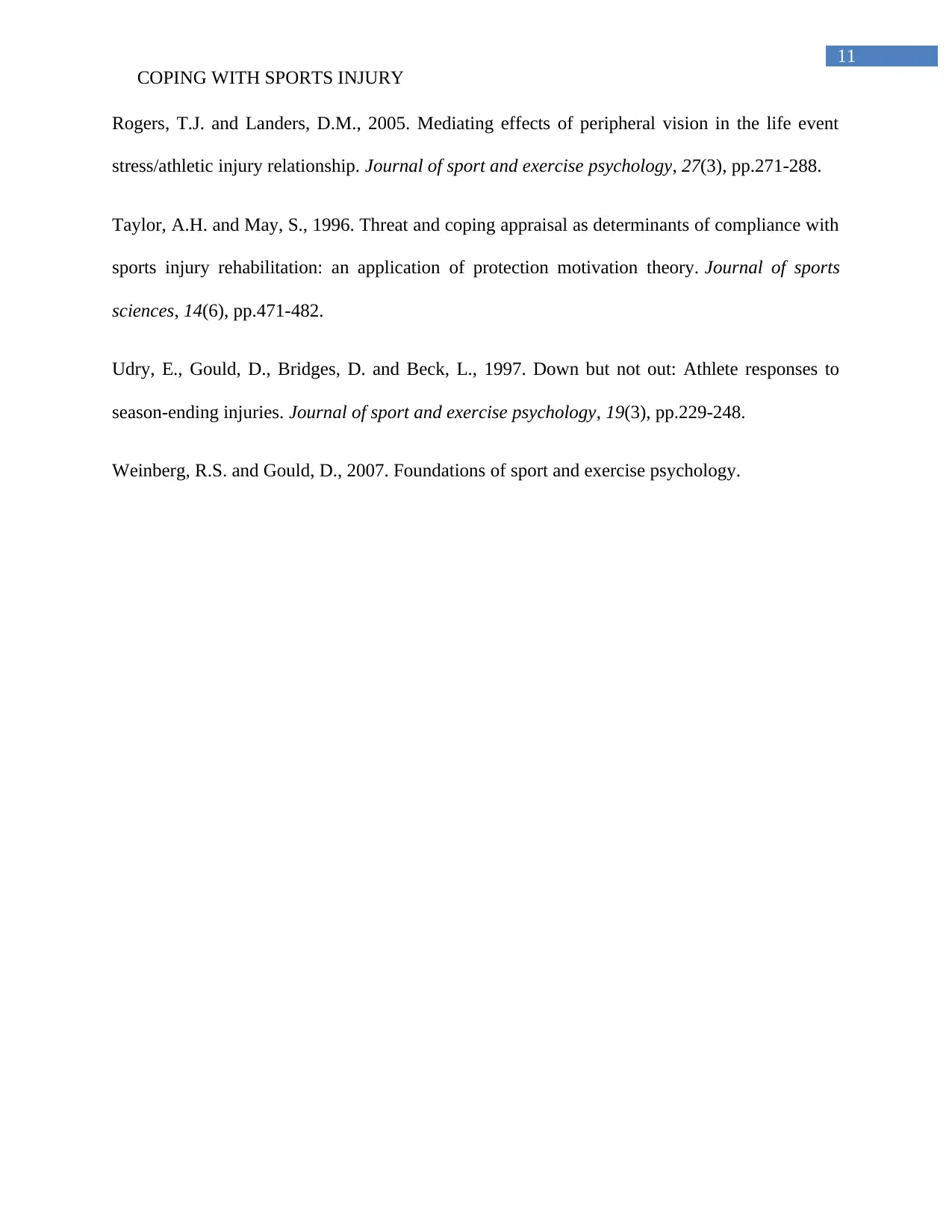
11
COPING WITH SPORTS INJURY
Rogers, T.J. and Landers, D.M., 2005. Mediating effects of peripheral vision in the life event
stress/athletic injury relationship. Journal of sport and exercise psychology, 27(3), pp.271-288.
Taylor, A.H. and May, S., 1996. Threat and coping appraisal as determinants of compliance with
sports injury rehabilitation: an application of protection motivation theory. Journal of sports
sciences, 14(6), pp.471-482.
Udry, E., Gould, D., Bridges, D. and Beck, L., 1997. Down but not out: Athlete responses to
season-ending injuries. Journal of sport and exercise psychology, 19(3), pp.229-248.
Weinberg, R.S. and Gould, D., 2007. Foundations of sport and exercise psychology.
COPING WITH SPORTS INJURY
Rogers, T.J. and Landers, D.M., 2005. Mediating effects of peripheral vision in the life event
stress/athletic injury relationship. Journal of sport and exercise psychology, 27(3), pp.271-288.
Taylor, A.H. and May, S., 1996. Threat and coping appraisal as determinants of compliance with
sports injury rehabilitation: an application of protection motivation theory. Journal of sports
sciences, 14(6), pp.471-482.
Udry, E., Gould, D., Bridges, D. and Beck, L., 1997. Down but not out: Athlete responses to
season-ending injuries. Journal of sport and exercise psychology, 19(3), pp.229-248.
Weinberg, R.S. and Gould, D., 2007. Foundations of sport and exercise psychology.
⊘ This is a preview!⊘
Do you want full access?
Subscribe today to unlock all pages.

Trusted by 1+ million students worldwide
1 out of 12
Your All-in-One AI-Powered Toolkit for Academic Success.
+13062052269
info@desklib.com
Available 24*7 on WhatsApp / Email
![[object Object]](/_next/static/media/star-bottom.7253800d.svg)
Unlock your academic potential
Copyright © 2020–2025 A2Z Services. All Rights Reserved. Developed and managed by ZUCOL.


